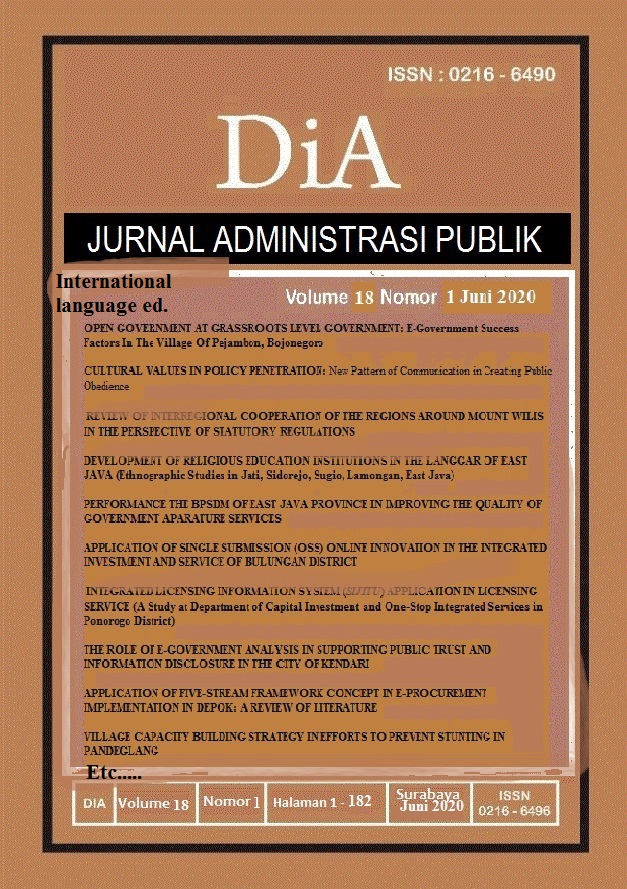CULTURAL VALUES IN POLICY PENETRATION: New Pattern of Communication in Creating Public Obedience
DOI:
https://doi.org/10.30996/dia.v18i1.3575Keywords:
cultural values, communication, policy, obedienceAbstract
Many studies related to the policy of street vendors relocation in various cities in Indonesia, even in the world. However, there is still limited research examining the cultural variability of government and street vendors. Culture is not the only variable which can influence the behaviour of street vendors in responding the policies, but omnipresent cultural existence becomes a major factor in communication of government policies. The research was carried out in a qualitative explanatorywith the main focus on the implementation of street vendor policy relocation in Yogyakarta City, Indonesia. Data collection techniques were carried out through in-depth interviews with the actors or communicators in the communication of relocation policies to street vendors. The success or failure of the public policy implementation has many determinants. In a system perspective, a policy is in the frame of the environment which requires the integration of all elements which can influence it. This research has found that culture is the main determinant whichcan be one of the determinants of successful communication, creating compliance, forming positive opinions, conformity, and building consensus on the policy of street vendors relocation in Yogyakarta City, Indonesia.
Downloads
References
Endraswara, S. (2010). Javanese Ethics of Life: Ethical Guidelines in Exploring Daily Life. Yogyakarta: Narasi. In Indonesian.
Giddens, A. (2010). Structuration Theory: Basics Community Social Structure Formation. Yogyakarta: Pustaka Pelajar. In Indonesian.
Gudykunst, W. B., and Mody, B. (2002). Handbook of International and Intercultural Communication (Second Edi). London-New Delhi: Thoousand Oaks.
Hofstede, G. (2011). Dimensionalizing Cultures: The Hofstede Model in Context. Online Readings in Psychology and Culture, 2(1), 1–26. https://doi.org/10.9707/2307-0919.1014
Kasali, R. (2006). Public Relations Management, Concepts and Applications in Indonesia. Jakarta: Pustaka Utama Grafiti. In Indonesian.
Manning, C., & Effendy, T. N. (1985). Urbanization of Unemployment and the Informal Sector in the City. Jakarta: Gramedia.
Matsumoto, D., Yoo, S. H., Nakagawa, S., Alexandre, J., Altarriba, J., Anguas-Wong, A. M., … Yoo, S. H. (2008). Culture, Emotion Regulation, and Adjustment. Journal of Personality and Social Psychology, 94(6), 925–937. https://doi.org/10.1037/0022-3514.94.6.925.
Mulyana, D. (2000). Intercultural Communication: A Guide to Communicating with Different People of Cultural. Bandung: Remaja Rosdakarya. In Indonesian.
Nasution, Z. (2001). Development Communication: Introduction to Theory and Implementation. Jakarta: RajaGarfindo Persada. In Indonesian.
Nugroho, R. (2015). Public Policy in Developing Countries. Yogyakarta: Pustaka Pelajar. In Indonesian.
Ritzer, G. (2012). Sociological Theory. Yogyakarta: Pustaka Pelajar. In Indonesian.
Ruben, B. D., & Stewart, L. P. (2014). Communication and Human Behavior. Jakarta: RajaGarfindo Persada. In Indonesian.
Samovar, L. A., Porter, R. E., & McDaniel, E. R. (2010). Communication Between Cultures, Jakarta: Salemba Humanika. In Indonesian.
Servaes, J. (2002). Communication for Development. Paris: UNESCO.
Srampickal, J. (2006). Development and participatory communication. Communication Research Trends, 25(2), 3+. Retrieved from http://go.galegroup.com.ez.sun.ac.za/ps/i.do?id=GALE%7CA148565540&v=2.1&u=27uos&it=r&p=AONE&sw=w.
Susan, N. (2009). Sociology of Conflict and Contemporary Conflict Issues. Jakarta: Kencana.
Tubbs, S. L., & M. (2008). Human Communication. Bandung: Rosdakarya. In Indonesian.
West, R., & Turner, L. H. (2008). Introduction to Communication Theory: Analysis and Applications. Jakarta: Salemba Humanika. In Indonesian.
Winarno, B. (2013). Development Ethics. Yogyakarta: CAPS (Center for Academic Service). In Indonesian.
Wirastami, P. A. (2015). PKL Dominasi Pelanggaran Perda. Tribun Jogja.Com. Retrieved from http://jogja.tribunnews.com/2015/05/01/pkl-dominasi-pelanggaran-perda
Yustika, A. E. (2003). Country vs. Poor People. Yogyakarta: Pustaka Pelajar. In Indonesian.
Downloads
Published
How to Cite
Issue
Section
License
The DiA journal allows authors to retain the copyright of their papers without limitation. Authors may grant publishers non-exclusive publishing rights to publish articles. Granting first publishing rights to publishers also qualifies as unlimited copyright (because there are no restrictions imposed by publishers on author copyright).






